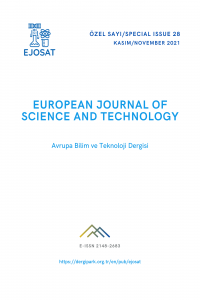Öz
We discuss the feedback algorithm for the optogenetic control over the membrane conductance in the frame of Grossman-Nikolic-Toumazou-Degenaar (GNTD) ordinary differential system modeling the response of channelrhodopsin-2 (ChR2) expressing neurons to the light stimulation with the various types of ChR2 mutants. The GNTD population dynamics contains four functional states (two open and two closed) with the transitions among them due to photo-excitations with the stimulating light or decays back from the open to the closed states. The control signal in the model is defined via the photon flux per one ChR2 in the dimensionless form. The control goal is the total conductance of a neural section due to ChR2. We formulate the control algorithm in the form of Fradkov’s speed gradient method driving the dynamical system in the phase space such that the target function for the discrepancy between the actual total conductance and its desired level is minimized. We derive the explicit equation for the photon flux field stabilizing the conductance characteristics and perform the numerical simulation for the controlled GNTD differential system to prove the achievability of the control goal. Our approach can be useful for modeling different experimental problems of optogenetics, particularly, for driving the collective dynamics of neural cells in epilepsy, depression, and tumors of the central nervous system.
Anahtar Kelimeler
Optogenetics ChR2 channel Membrane conductance Feedback control Speed gradient algorithm
Kaynakça
- Camporeze, B., et al. (2018). Optogenetics: the new molecular approach to control functions of neural cells in epilepsy, depression and tumors of the central nervous system, The American Journal of Cancer Research, 8(10), 1900-1918.
- Forli, A., et al. (2021). Optogenetic strategies for high-efficiency all-optical interrogation using blue-light-sensitive opsins, eLife, 10, e63359.
- Fradkov, A. L. (2007). Cybernetical Physics: From Control of Chaos to Quantum Control, Berlin, Heidelberg, Germany: Springer-Verlag.
- Grossman, N., et al. (2011). Modeling study of the light stimulation of a neuron cell with channelrhodopsin-2 mutants, IEEE Transactions on Biomedical Engineering, 58(6), 1742-1751.
- Hegemann, P., et al. (2005). Multiple photocycles of channelrhodopsin, Biophyical. Journal, 89, 3911-3918.
- Kolesnikov, A. A. (2013). Synergetic Control Methods of Complex Systems, 2nd ed., Moscow: URSS Publ.
- Nagel, G., et al. (2003) Channel-rhodopsin-2, a directly light-gated cation-selective membrane channel, Proceedings of the National Academy of Sciences of the United States of America, 100, 13940-13945.
- Oprisan, S. A., et al. (2015). Reconstructing dynamical models from optogenetic data, BMC Neuroscience, 16, 143.
- Williams, J. C., Entcheva, E. (2015). Optogenetic versus electrical stimulation of human cardiomyocytes: Modeling insights, Biophysical Journal, 108, 1934-1945.
- Zou, L., et al. (2021). Self-assembled multifunctional neural probes for precise integration of optogenetics and electrophysiology, Nature Communications, 12, 5871.
Öz
Channelrhodopsin-2'yi (ChR2) ekspres eden nöronların, ChR2 mutantlarının çeşitli tipleriyle ışık uyarımına cevabını modelleyen Grossman-Nikolic-Toumazou-Degenaar (GNTD) sıradan diferansiyel sistemi çerçevesinde zar iletkenliği üzerindeki optogenetik kontrol için geri besleme algoritmasını tartışıyoruz. GNTD popülasyon dinamiği, aralarında geçiş yapabilen ikisi açık ve ikisi kapalı olmak üzere dört işlevsel durum içermektedir. Bu geçişler, uyaran ışığın fotoeksitasyonları ya da açık durumlardan kapalı durumlara geri bozulmalar nedeniyle gerçekleşmektedir. Model içindeki kontrol sinyali, boyutsuz şekilde, ChR2 başına foton akısı üzerinden tanımlanmaktadır. Kontrolün amacı ChR2 nedeniyle bir nöral kısmın toplam iletkenliğidir. Var olan toplam iletkenlik ve bu iletkenliğin istenen seviyesi arasındaki uyuşmazlığı temsil eden hedef fonksiyonunun en aza indirilmesi sağlanacak şekilde, faz uzayı içindeki dinamik sistemi yönlendiren Fradkov'un hızlı gradyan yöntemi biçimindeki kontrol algoritmasını formülleştirmekteyiz. İletkenlik özelliklerini kararlı hale getiren foton akı alanı için açık denklemi türetmekte ve kontrol amacına ulaşabilirliğin kanıtı olarak kontrol altındaki GNTD diferansiyel sistemi için sayısal benzetim gerçekleştirmekteyiz. Yaklaşımımız optogenetiğin farklı deneysel problemlerini modellemede, özellikle, epilepsi, depresyon ve merkezi sinir sistemi tümörlerindeki sinir hücrelerinin toplu dinamiğini yönlendirmede faydalı olabilmektedir.
Anahtar Kelimeler
Optogenetik ChR2 kanalı Membran iletkenliği Geribesleme kontrolü Hızlı gradyan algoritması
Kaynakça
- Camporeze, B., et al. (2018). Optogenetics: the new molecular approach to control functions of neural cells in epilepsy, depression and tumors of the central nervous system, The American Journal of Cancer Research, 8(10), 1900-1918.
- Forli, A., et al. (2021). Optogenetic strategies for high-efficiency all-optical interrogation using blue-light-sensitive opsins, eLife, 10, e63359.
- Fradkov, A. L. (2007). Cybernetical Physics: From Control of Chaos to Quantum Control, Berlin, Heidelberg, Germany: Springer-Verlag.
- Grossman, N., et al. (2011). Modeling study of the light stimulation of a neuron cell with channelrhodopsin-2 mutants, IEEE Transactions on Biomedical Engineering, 58(6), 1742-1751.
- Hegemann, P., et al. (2005). Multiple photocycles of channelrhodopsin, Biophyical. Journal, 89, 3911-3918.
- Kolesnikov, A. A. (2013). Synergetic Control Methods of Complex Systems, 2nd ed., Moscow: URSS Publ.
- Nagel, G., et al. (2003) Channel-rhodopsin-2, a directly light-gated cation-selective membrane channel, Proceedings of the National Academy of Sciences of the United States of America, 100, 13940-13945.
- Oprisan, S. A., et al. (2015). Reconstructing dynamical models from optogenetic data, BMC Neuroscience, 16, 143.
- Williams, J. C., Entcheva, E. (2015). Optogenetic versus electrical stimulation of human cardiomyocytes: Modeling insights, Biophysical Journal, 108, 1934-1945.
- Zou, L., et al. (2021). Self-assembled multifunctional neural probes for precise integration of optogenetics and electrophysiology, Nature Communications, 12, 5871.
Ayrıntılar
| Birincil Dil | İngilizce |
|---|---|
| Konular | Mühendislik |
| Bölüm | Makaleler |
| Yazarlar | |
| Yayımlanma Tarihi | 30 Kasım 2021 |
| Yayımlandığı Sayı | Yıl 2021 Sayı: 28 |


